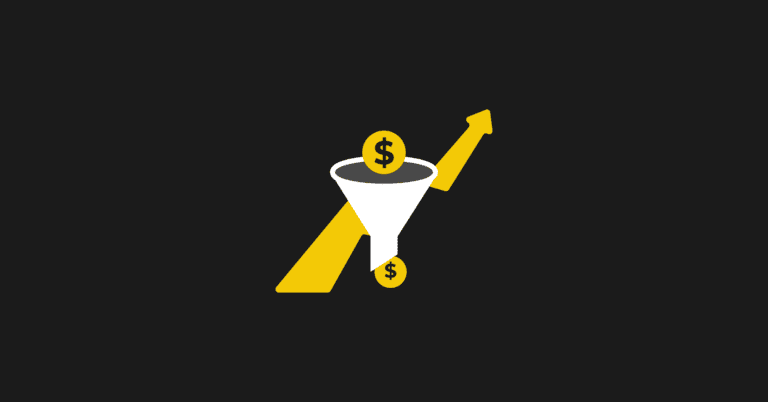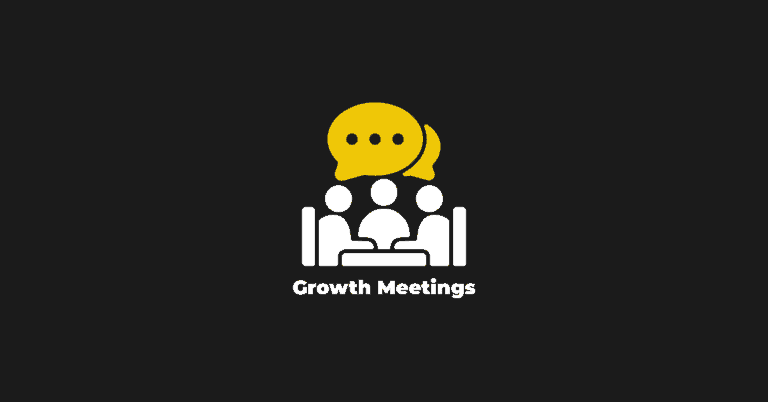Search engine optimization (SEO) is a key piece of product-led growth. It goes beyond SaaS content strategy and involves your Marketing, Product, and Engineering teams to entice your target audience into trying – and ultimately purchasing – your product.
I'm no longer at Typeform, but during my time there we used SEO as part of our marketing mix and I'm going to share six top SEO secrets I learned as the Head of Growth Marketing.
Here they are:
- Use internal links
- Build upon existing topic authority
- Meet user demand
- Simple conversion rate optimization is powerful
- Double down on your strengths
- Build a link-building machine
Watch the video or read on to dive into the details of each and discover ways to enhance your SEO strategy below.
As you delve further, you'll come to realize that crafting and executing a sustainable SEO strategy demands dedication and experimentation, yet the potential rewards are limitless.
Benefits of SEO
SEO offers numerous benefits for your SaaS businesses. By investing in SEO strategies and optimizing your website, you can improve your online visibility, attract more visitors, and ultimately drive conversions.
Increase Organic Traffic and Visibility
Implementing SEO strategies can help your website rank higher in search engine results pages (SERPs), leading to increased organic traffic. By optimizing your website's content and structure, you can improve its visibility to potential customers who are actively searching for products or services related to your industry. This increased visibility can result in more website visits and ultimately more conversions.
Drive Traffic
One of the key benefits of SEO is its ability to drive evergreen traffic to your website. Unlike paid advertising, which stops generating traffic once the campaign ends, SEO-optimized content can continue to attract visitors long after it's been published.
Build Credibility and Trust
When your website appears on the first page of search engine results, it signals to users that your product is trustworthy and authoritative. People tend to trust search engines, so if your website is ranking well, it can boost your credibility and establish trust with potential customers.
Cost-Effective Marketing Strategy
Compared to other digital marketing sales tactics, SEO is a cost-effective strategy that can deliver long-term results. While it may require an initial investment in optimizing your website and creating quality content, the ongoing maintenance and optimization costs are relatively low.
Stay Ahead of the Competition
In today's competitive digital landscape, most businesses are aware of the importance of SEO. By neglecting SEO, you risk falling behind your competitors who are actively optimizing their websites. By implementing effective SEO strategies (and using my secrets in the next section), you can stay ahead of the competition and ensure that your website is visible to potential customers who are searching for products or services in your industry.
With the advantages of SEO outlined, let's dive into my secrets for optimizing your company's strategy.
Top 6 SEO Secrets
In the realm of SEO, certain techniques can take your online presence from ordinary to exceptional. Dive in and explore the secrets that propelled Typeform's SEO to remarkable success and can help generate leads for your business.
#1 SEO Secret: Use internal links
Typeform is a SaaS company that creates people-friendly forms and surveys. It is a very design-focused company, and when we started our SaaS SEO efforts, the website was very minimalist. There wasn't a footer, there were no links. It was the same with all of the landing pages that we were building. All these pages were floating around in space because they weren't linked from anywhere. So what did we do?
We added a footer.
And yes, this is super basic stuff, but these internal links played a major role in SEO at Typeform. We also updated our content strategy to build internal links into all of our existing content. For example, we really worked hard on putting internal links into this page, our survey maker page, and you can see the increase in traffic as a result.
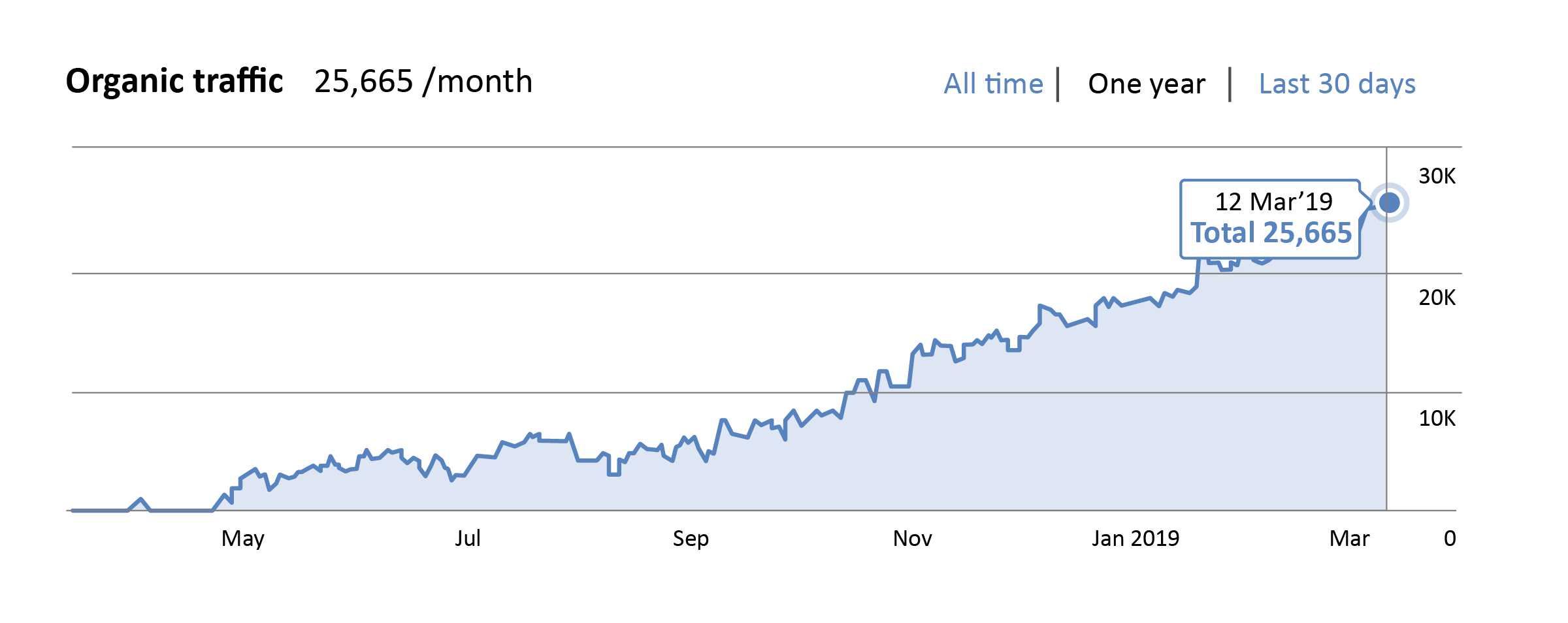
We were building and launching content on a daily basis, moving fast, and didn't have a process for creating internal links. So, once per week, we had an "internal linking party." (We called it a party, to try to make it fun.)
We'd spend time as a team adding internal links to the pages that we wanted to rank. But we soon found out that you have to build a process for internal links.
You can't underestimate internal links. They're super important, and internal linking needs to be part of your SEO process. So how do you start? Here are two steps to conquer this:
- Add a task to your content process, right after you upload content to your CMS.
- Add five internal links to the piece of content.
Some of the biggest wins at Typeform were focusing on adding these internal links to different pieces of content. This actually allowed us to get above SurveyMonkey and Wikipedia for keywords such as "free survey maker."
I really never thought that we would ever get above SurveyMonkey, but we actually managed to do it.
Another place we added internal links was in the header. On the Spanish website of Typeform, we added: "encuestas" ("polls") and "formularios" ("forms") as an experiment. After adding the links, we found that these pages ranked faster.

So, think about how you can build bigger menus because Google prioritizes the links they find in the header. Try and plan the architecture of your website around these pages that you want to rank in your SEO strategy.
#2 SEO Secret: Build upon existing topic authority.
What does this mean, "building upon existing topic authority?"
Let me give you an example.
Typeform has a lot of different use cases for quizzes and surveys, and you can use Typeform for many things. We were thinking of different ways in which we could attract personas as part of our marketing strategy, and thinking of the type of content that we could make.
For example, we were thinking about the topic of customer satisfaction. You can run customer satisfaction surveys, you can create net promoter score ("NPS") surveys, all in Typeform. We decided to create content around it and focused on NPS because it's specific and people after NPS are serious.
This appeared to be a really good bet because there's a difference between a generic survey term and NPS in terms of intent and buying power. We launched all of this content and did our whole content marketing process, including adding those internal links.
This actually didn't move the needle, at all. We waited three months. We gave it time to run, evaluate engagement metrics, and really see how it was performing. It didn't do anything at all, so we went back to the drawing board.
We looked at what was already ranking on our website. Our survey maker page was ranking really well. And we thought, let's double down on what works. So we started to create content related to that survey maker page. For example, how to write a survey intro, survey versus questionnaire, and post-event survey questions.
We created the content.
We saw an uplift. As you can see here, we went from almost nothing to nearly 40,000 views per month.
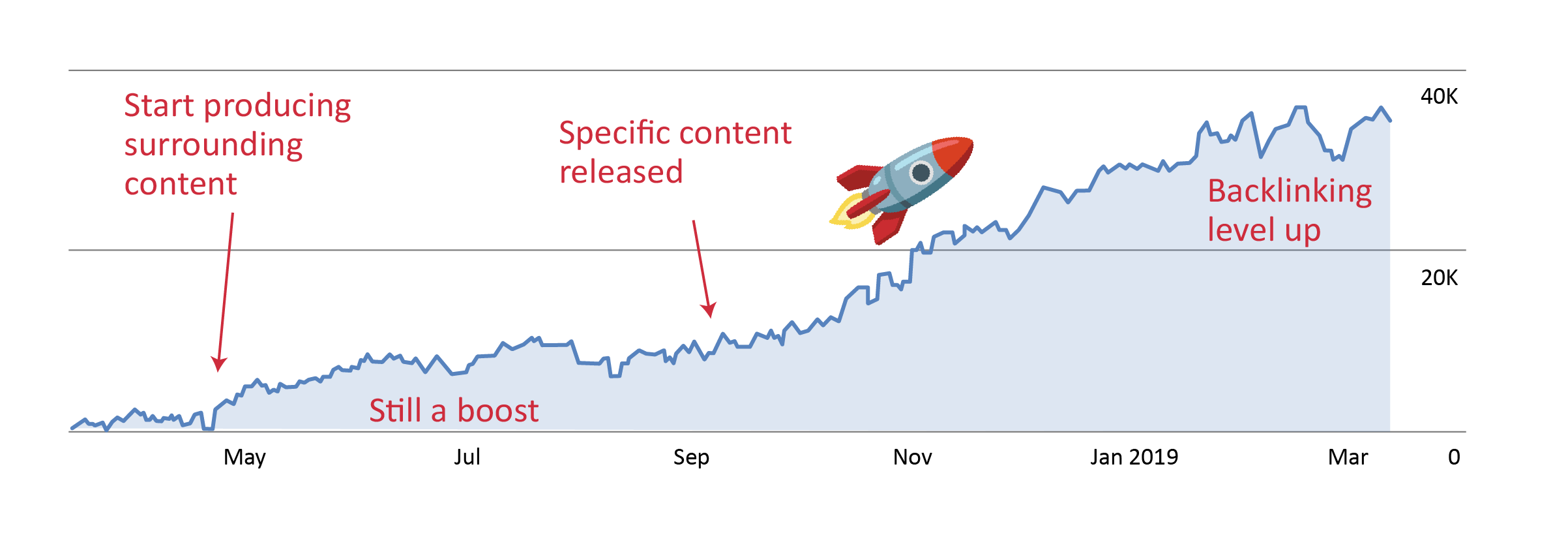
By focusing on what is already working and brainstorming based on that, you're going to have results a lot faster than creating brand-new topics. That's because you've already created and validated that topic authority to Google. Moving from 1,700 new visits per month to 34,000 new visits per month was a big win.
Over time those visits turned into customers. At Typeform, it takes three months on average from signup to new subscription. You need to take into account the lag in terms of seeing the actual new monthly recurring revenue (MRR) generated from the initiative. There will be a lag from SEO, and then a lag from signup to subscription. However, we soon started to see the fruits of our labor.
We created more around the survey maker topic, and we started brainstorming around other existing topics with authority. This led to really big wins.
When you think about creating and brainstorming new content for your website, look at what is already ranking and think, "how can I branch off this? What opportunities do I have to double down on what's really working?"
This is going to allow you to scale SEO 10 times faster than if you just try to tackle brand new topics that Google hasn't validated your authority in yet.
#3 SEO Secret: Meet user demand.
This is one of my favorite SEO secrets, and here's how I learned this lesson. We produced an article on how to write a set of questions that receives results.
We followed our process: we chose a topic close to one with authority, we did our keyword research, and we did our technical SEO, on-page, and off-page.
But nothing happened.
We thought we did everything right. We did everything by the book, but we could not move the needle – even though we were creating content close to what was already working, focusing on our topic authority, and doing internal linking. Nothing worked.
Then, we looked at the top 10 results in Google for the topic.
We saw different patterns emerging from other people's content that Google was ranking on the first page. There was a specific pattern to the content used in other companies' SaaS marketing. It started with a definition of the type of question, then it gave a description, and then it gave an example.
So, we edited our survey questions article to match the same format: definition, description, and example. Literally, 30 minutes later it jumped to the first page of Google simply by asking Google to reevaluate the content.
And this wasn't the only one. We did this again for the topics "survey versus questionnaire," and "survey intros." We updated the content based on the patterns we saw in those highly ranked pages, and we had a huge increase in traffic.
In hindsight, we should have already been doing that in our SEO process. Before you create the content, you need to look at the top 10 results in Google because Google is using its natural language processing to analyze the structure.
Don't just try to beat the top 10 results; really analyze the patterns that you're finding and apply them to your content because chances are it's going to work super well for your growth strategy.
#4 SEO Secret: Simple conversion rate optimization is powerful.
When we were looking at the SEO marketing channel at Typeform, it didn't stop at traffic. We analyzed ROI based on new MRR and how SEO impacted business. Naturally, we wanted to create content that was going to bring more sign-ups that would lead to additional MRR.
We ran A/B tests to optimize conversion rates on our landing pages using Google Optimize. This is one marketing test we did on our form builder page. We changed the H1 to be much more benefit-driven: "A fast form maker that gets you 3X more completions."
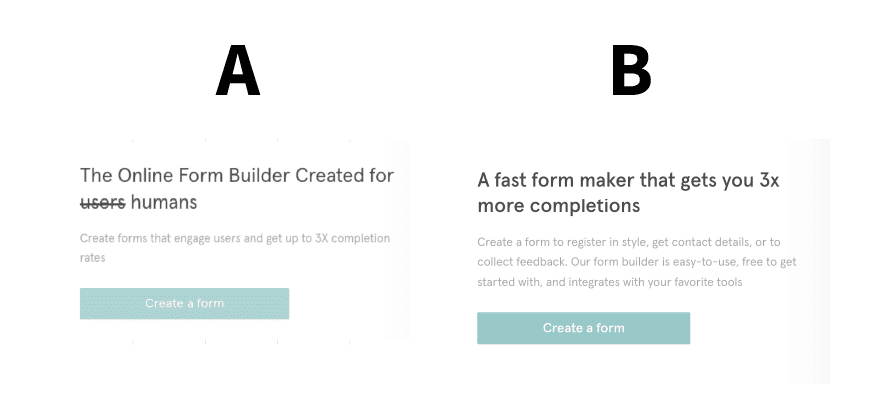
The test ran for around three weeks, and we increased signups by 15% doing this simple change.
However, we know that sign-ups are a vanity metric. Even though you might increase signups, you might not increase new customers because it's not deep enough in the marketing funnel to predict new customers.
Instead, we focused on our customer activation, which is when a user signs up, creates a Typeform, and previews it. This activation metric correlated to both retention and revenue.
Our A/B testing didn't focus on signups. We focused on Activations. We had a 15% increase in signups, but we actually saw a 20% increase in Activations.
This is a lot more powerful.
We were impacting the bottom line a lot more than if we'd only been focusing on signups. However, in this instance, we actually got more people using the product.
We did that by talking about the product, the benefits, and the end result; the actual value you receive from Typeform. This had an impact further down the funnel.
Don't just look at your super-leading metric, such as sign-ups. Have your activation metric in mind. Do your A/B testing based on your activation metric, and see how you can impact that. That will lead to a bigger impact on MRR for your SaaS product.
#5 SEO Secret: Double down on your sweet spot.
For Typeform, our sweet spot was templates.
For example, we have templates for job applications, registration forms, employee satisfaction surveys, and hundreds more. We did some marketing research and found any new template that ranked on Google would bring four new customers per year (on average). By understanding this, we were able to attach an ROI to our efforts.
We decided to double down on what was going to bring in new MRR: to go deep on templates.
Other successful product-led growth companies have really doubled down on this, too. For example, Canva has more than 50,000 templates in its design gallery, and Wix has website templates. They know that they can rank for different keywords using each template. They know people are going to activate when they use this template, and they know they're going to upgrade.
This isn't just an acquisition play, either. Templates are also an Activation play. They don't just attract new people to your product. Templates also allow your users to learn how to use the product a lot faster. This brings in revenue and retains users.
Templates are a super powerful product-led growth strategy. Templates with high Activation rates and high conversion rates to bring in more MRR faster were our focus because as an SEO team, we weren't just focused on traffic or customer acquisition. We were actually focused on MRR, brought through the SEO channel because we knew that we could build the business case to get more resources for our marketing team to bring in organic traffic.
We built our own template galleries that helped us rank for new keywords. For example, surveys, questionnaires, forms, quizzes, polls, and invitations.

We also added copy, "Not finding what you're looking for? Let us know." This led to a form where potential customers could submit ideas they couldn't find in our template gallery. So we also asked our community and once we created the templates, we'd let them know it was available.
We really systemized the creation of templates at Typeform. We had our customer requests going into Trello, which allowed us to prioritize the templates. The design team would pick up these template briefs, and at the same time, we would run them through our content creation process. The design and content processes went on in tandem, then we'd upload it to our CMS and finish our SEO process.
We systemized this process so we could scale it further, by going really deep into our sweet spot of templates.
#6 SEO Secret: Build a link-building machine.
How do you build a link-building machine?
Ten years ago, you would exchange links with different websites. And it would work. Google would see the links as referral links, and you would go increase your rankings. But as we now know, that no longer works. You can't just build content. As we know, you also have to build backlinks.
So, we built a link-building machine.
We built a loop: someone would search "create an online form," and they would find us on the results page on Google. They would sign up and create a contact form and would embed the contact form on their website. That automatically created a backlink to Typeform, which in turn increased the position of our contact form page in Google results. In turn, this allowed more people to find Typeform.
This content loop was self-fulfilling and drove our growth. It allowed us to rank for terms like "free contact form." We built a machine that was building links. That said, these links are quite weak links, so this was more of a growth hack to get us ranking a lot faster.
The other part of our link-building machine was proactive outreach for guest posting and other strong SaaS link-building techniques. These links would ensure that we would continue ranking in the mid to long term.
Integrating SEO into Your SaaS Marketing Strategy
By incorporating my SEO secrets into your marketing strategy, you can attract more qualified leads and improve your overall online presence.
Here are some key insights and strategies to help you integrate SEO effectively:
- Keyword Research: Conduct thorough keyword research to identify the most relevant and high-volume keywords in your industry. Use tools like Google Keyword Planner or SEMrush to find keywords that align with your target audience's search intent.
- On-Page Optimization: Optimize your website's on-page elements, such as meta tags, headings, and content, to improve its visibility in search engine results. Ensure that your keywords are strategically placed throughout your website and that your content is informative and engaging.
- Content Marketing: Create valuable and informative content that addresses the pain points of your target audience. Incorporate your target keywords naturally within your content to improve its relevance and visibility. Regularly publish blog posts, articles, and guides to establish your brand as a thought leader in your industry.
- Link Building: Build a strong backlink profile by acquiring high-quality, relevant backlinks from reputable websites. Guest posting, influencer outreach, and content promotion are effective strategies to earn backlinks and improve your website's authority.
- Technical SEO: Optimize your website's technical aspects, such as site speed, mobile-friendliness, and crawlability, to enhance user experience and search engine visibility. Conduct regular website audits to identify and fix any technical issues that may hinder your SEO efforts.
- Analytics and Monitoring: Regularly track and analyze your SEO performance using tools like Google Analytics and Google Search Console. Monitor your keyword rankings, organic traffic, and user behavior to identify areas for improvement and refine your SEO strategy.
Common SaaS SEO Mistakes to Avoid
When it comes to SaaS SEO, you want to bring the right people to the right pages at the right time.
However, in the fast-paced world of a SaaS start-up, it's easy to overlook some critical elements of a proper SEO strategy.
Here are simple SEO mistakes that even the best SaaS companies fall victim to:
Neglecting Keyword Research
One common mistake is neglecting keyword research. Without proper keyword research and integration, your site might struggle to rank, making discovery a challenge. Conduct thorough research and sprinkle relevant keywords across your content.
Ignoring On-Page Optimization
Another mistake is ignoring on-page optimization. This includes optimizing your page titles, meta descriptions, headers, and content to align with your target keywords.
Overlooking Technical SEO
Technical SEO is often overlooked but plays a crucial role in your website's performance and visibility. Ensure that your website is properly indexed, has a clean URL structure, loads quickly, and is mobile-friendly.
Neglecting Content Marketing
Content marketing is an essential component of any successful SEO strategy. By regularly creating high-quality, informative content that addresses your target audience's pain points, you can attract more organic traffic and establish your brand as a thought leader in your industry.
Failing to Build High-Quality Backlinks
Backlinks are an important ranking factor in search engine algorithms. By actively seeking out opportunities to earn backlinks from relevant and authoritative sources, you can improve your website's authority and visibility in search engine results.
Not Monitoring and Analyzing Performance
Lastly, failing to monitor and analyze your SEO performance can prevent you from identifying and addressing any issues or opportunities for improvement. Regularly track your website's rankings, organic traffic, conversion rates, and other key metrics to gain insights into what's working and what needs adjustment in your SEO strategy.
SEO Ranking Tips
While there is never a one-size-fits-all to a SaaS SEO strategy, I hope that my SEO secrets and strategy help your product-led company.
Each of my SEO secrets has key takeaways that I want you to consider when trying to improve your SEO performance:
- Never underestimate internal linking
- Build upon topic authority
- Always test
- Give users the information they want
- Replicate good content
- Build link-building machines
By avoiding common SaaS SEO mistakes and implementing a comprehensive SEO strategy, you can improve your website's visibility, attract more targeted traffic, and ultimately drive more conversions and revenue for your SaaS business.
Join ProductLed Academy to scale your business, faster
Understanding SaaS SEO is only one part of executing a successful acquisition strategy. In ProductLed Academy, we can help you nail down your messaging and create an irresistible offer, so you can gain more signups and build a self-serve model that converts.
This 12-month program is comprised of four components:
- Weekly 60-minute group coaching call with Wes Bush where you'll go through each of the components of the ProductLed Method to master a self-serve model.
- Weekly non-negotiable tasks to keep you accountable.
- Access to an exclusive ProductLed Founder Community so you can meet other ambitious founders and receive support 24/7.
- Access to the ProductLed Vault where you'll gain access to all of our programs (including ProductLed Acquisition), templates, and frameworks.
If you're ready to break through to the next level and move beyond SEO to master your acquisition, be sure to check out ProductLed Academy





